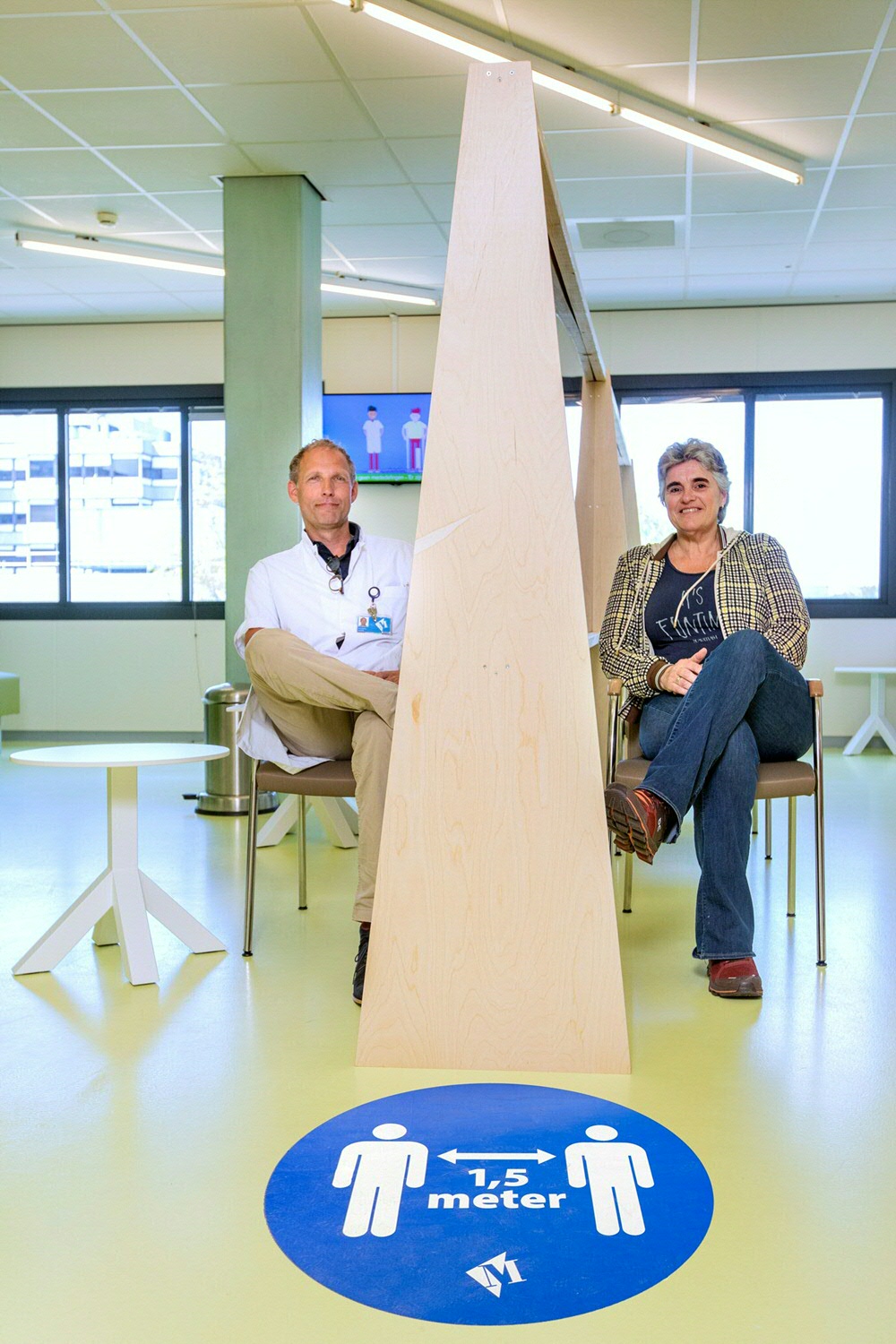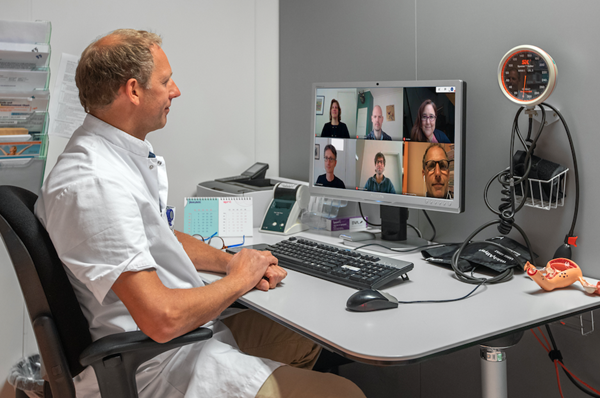Martini Ziekenhuis en RUG werken samen aan innovatieve applicatie voor plannen poliklinische '1,5 meter zorg'
Bij het opstarten van de reguliere zorg is het garanderen van patiëntveiligheid het belangrijkste uitgangspunt. Het Martini Ziekenhuis wil zoveel mogelijk patiënten helpen, maar het mag niet té druk worden in het ziekenhuis en ook niet in de wachtkamers. Het Martini en de Rijksuniversiteit Groningen (RUG) werken daarom samen aan het ontwikkelen van een innovatieve applicatie voor het plannen van poliklinische ‘1,5 meter zorg’. Dr. Justin Drupsteen, Manager Integraal Capaciteitsmanagement in het Martini Ziekenhuis: “Door de 1,5 meter maatregelen zal het aantal patiënten dat tegelijkertijd in een wachtkamer aanwezig is, soms met wel 75% verminderd moeten worden. Om patiënten zo goed mogelijk van dienst te kunnen zijn, moeten we een volledig nieuwe manier van plannen voor onze poliklinieken en diagnostiek als röntgen en echo introduceren.”
Patiëntveiligheid door planning
Vanaf eind april heeft het Martini Ziekenhuis het aandeel reguliere zorg weer verhoogd. Patiëntveiligheid is daarbij het belangrijkste uitgangspunt; denk aan maatregelen als eenrichtingsverkeer, screening bij de ingang en afstandsindicaties in de gangen. Ook in de wachtkamers wordt rekening gehouden met 1,5 meter afstand. Dat betekent dat er minder patiënten tegelijkertijd aanwezig kunnen zijn in een wachtkamer en daarmee dat er minder behandelkamers tegelijkertijd ingepland kunnen worden. Waar vóór de COVID-19 uitbraak het aantal artsen, verpleegkundigen of behandelkamers de restrictie voor de zorg was, is dat nu de wachtkamer.
Justin Drupsteen: “Uiteraard weten we dat er veel mensen wachten op hun behandeling of onderzoek. In deze situatie wil je ervoor zorgen dat de beschikbare ruimte optimaal benut wordt. Samen met de RUG werken we aan een tool waarin polikliniekplanningen worden gegenereerd die rekening houden met een groot deel van de uitdagingen van de 1,5 m samenleving. Om de tool zo goed mogelijk te laten werken is het belangrijk dat patiënten niet te laat komen maar ook niet veel te vroeg; hoe meer er wordt afgeweken van de afspraaktijd hoe voller de wachtkamers worden.”
Het plannen van onzekerheid of de onzekerheid van planning
De applicatie is door RUG-onderzoekers prof. dr. Iris Vis, prof. dr. Kees Jan Roodbergen, dr. Michiel uit het Broek en dr. Ilke Bakir ontwikkeld. Michiel uit het Broek, onderzoeker bij de vakgroep Operations van de Faculteit Economie en Bedrijfskunde, legt uit: "We hebben een wiskundig model ontwikkeld dat afsprakenschema's genereert waarbij zoveel mogelijk patiënten kunnen worden gezien, maar het aantal gelijktijdig wachtende patiënten zo laag mogelijk wordt gehouden, door toepassing van allerlei spreidingsopties. Zo starten niet alle afspraken tegelijk, verschuiven pauzes van artsen, worden vrije behandelkamers als wachtruimte gebruikt en wordt er ruimte tussen afspraken aangehouden. Dat is natuurlijk minder efficiënt voor de artsen, maar het is soms noodzakelijk om te kunnen garanderen dat er niet te veel patiënten tegelijk in de wachtkamer komen."
Iris Vis, hoogleraar Technische Bedrijfskunde: "De applicatie geeft ook inschattingen voor de risico's op mogelijke overschrijding van de maximale capaciteit van de wachtkamer. Immers er is altijd een kans dat het in de praktijk anders loopt dan verwacht, bijvoorbeeld doordat een afspraak uitloopt. Maar de tool kan natuurlijk nooit precies voorspellen hoe individuele artsen, medewerkers en patiënten zich gedragen. En ook niet of alle organisatorische maatregelen effectief geïmplementeerd zijn. Daarom is het belangrijk om langzaam op te bouwen."
Het idee is om te beginnen met een laag aantal afspraken, bijvoorbeeld op 40% van het normale aantal afspraken. Blijkt dat in de praktijk goed te lopen, dan kan daarna het aantal afspraken steeds in stapjes worden verhoogd aan de hand van de afsprakenschema's die de tool daarvoor geeft.
Testen
De eerste versie wordt nu getest bij de poli van de Obstetrie en Gynaecologie. Bij veel specialismen worden verschillende afspraaktypes onderscheiden, iets wat het plannen nog ingewikkelder maakt. Dr. Marinus van der Ploeg, gynaecoloog in het Martini: “We willen iedereen weer zo snel mogelijk de zorg verlenen die ze nodig hebben. Daarbij is spreiden in ruimte en tijd het devies. Dat is een enorme logistieke uitdaging en we zijn erg blij dat de RUG ons daarbij helpt". De tool is niet specifiek ontwikkeld voor Obstetrie en Gynaecologie; alle specialismen kunnen deze tool als planningsondersteuning gebruiken. Daarom wil het Martini Ziekenhuis de applicatie zo snel mogelijk gaan gebruiken op alle andere poli’s. Patiënten worden uiteraard uitgebreid geïnformeerd over de aangepaste logistiek in het ziekenhuis.

Volgende stappen
In het vervolgonderzoek wordt de applicatie uitgebreid door ook rekening te houden met praktische aspecten als beschikbaarheid van artsen en wensen over wat een goed afsprakenschema is. Daarnaast kunnen door toepassing van de tool inzichten worden verkregen in de effecten van de maatregelen op de beschikbare zorgcapaciteit in het ziekenhuis. Verder wordt verkend welke mogelijkheden er zijn tot automatische koppeling met de ziekenhuisinformatiesystemen. Momenteel werken de onderzoekers samen met het rekencluster van het Centrum voor Informatie Technologie van de RUG aan het ontwikkelen van een web-interface, en het berekenen van complexe schema's.
Andere ziekenhuizen die geïnteresseerd zijn in dit project kunnen meer informatie vinden op www.rug.nl/cope/1.5

Meer nieuws
-
10 november 2025
Decentralisatie van de jeugdzorg
-
31 oktober 2025
RUG speelt sleutelrol in circulair textielproject SORTED
